1lumen selects and reviews products personally. We may earn affiliate commissions through our links, which help support our testing.
Fenix PD25R review: EDC flashlight test

Fenix PD25R specifications
| Brand & Model | Fenix PD25R |
|---|---|
| Category | EDC Flashlight |
| LED | Luminus SST20 |
| Lumens | 800 Lumens |
| Beam intensity | 15,530 cd |
| Battery config. | 1*16340 / 1*CR123A |
| Onboard charging | USB-C |
| Modes | 5 |
| Blinkies | Strobe |
| Reflector | Smooth |
| Waterproof | IP68 |
| Review publication date | Aug 2022 |
Introduction:
Fenix makes a huge array of lights. In fact, they have an actual PDF catalog on their website (I imagine it’s probably also distributed in paper form as well) that is 48 pages long and chock-full of products ranging from tiny EDC lights all the way up to a couple really big boys that I’ve been fortunate enough to check out: the Fenix LR50R 12,000 lumen monstrosity and the Fenix HT30R 1500m throw LEP. If you need a light, chances are that Fenix will have a nice offering to fill that need.
By and large, I really like Fenix – my first “real” flashlight was a Fenix (the 187 lumen E25 model, if you’re curious). From my experience, Fenix lights are really well designed, they use quality materials and finishes, have great constant-current drivers, and publish truthful ANSI specs. I also just finished reviewing the small Fenix E18R V2.0 EDC light, and this new PD25R also uses the same battery (a 16340). The PD25R is an entirely different animal, though. While the E18R V2.0 was a tiny e-switch light with a TIR lens, the PD25R is a dual-switch reflector light with a waterproofed USB-C port. Not as small, but it definitely fills a more professional/tactical role.
Package quality.
The packaging for the Fenix PD25R is instantly recognizable as having come off the same line as the HT30R and E18R V2.0 that I just reviewed. They used the exact same design language and materials: a showy black and orange carton with a heavy-duty plastic tray inside. Arranged in the tray was:
- Fenix PD25R
- Battery
- Charging cable
- Spare o-rings
- Holster
- Pocket clip (pre-installed)
- Lanyard
- Manual and other literature
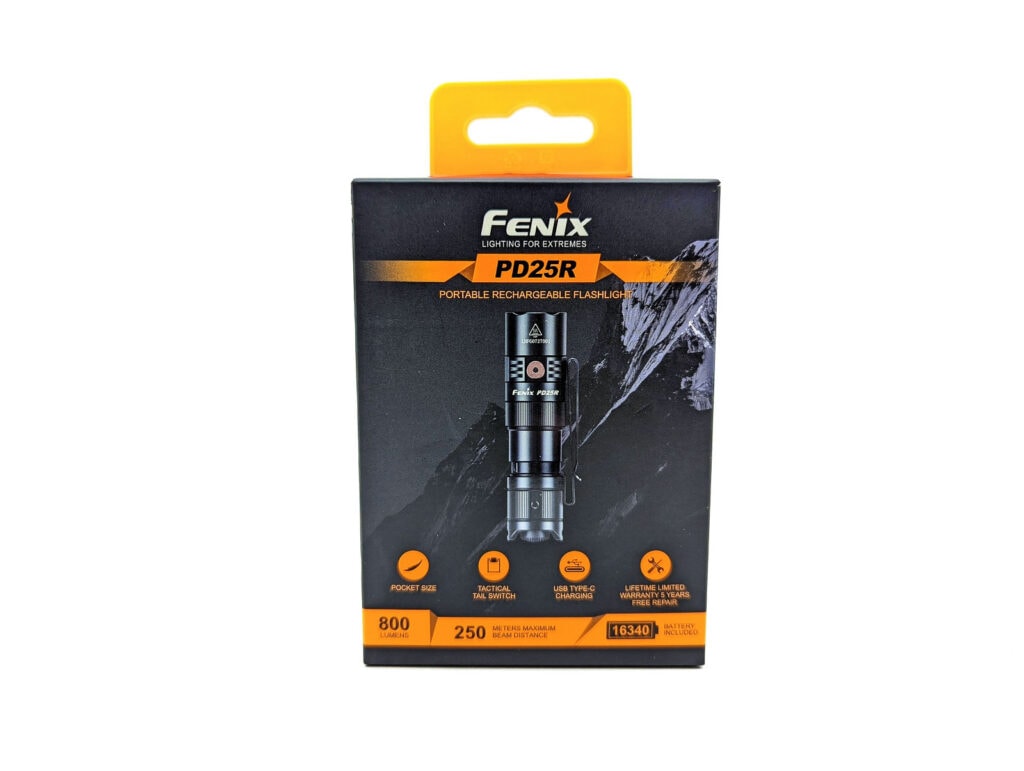
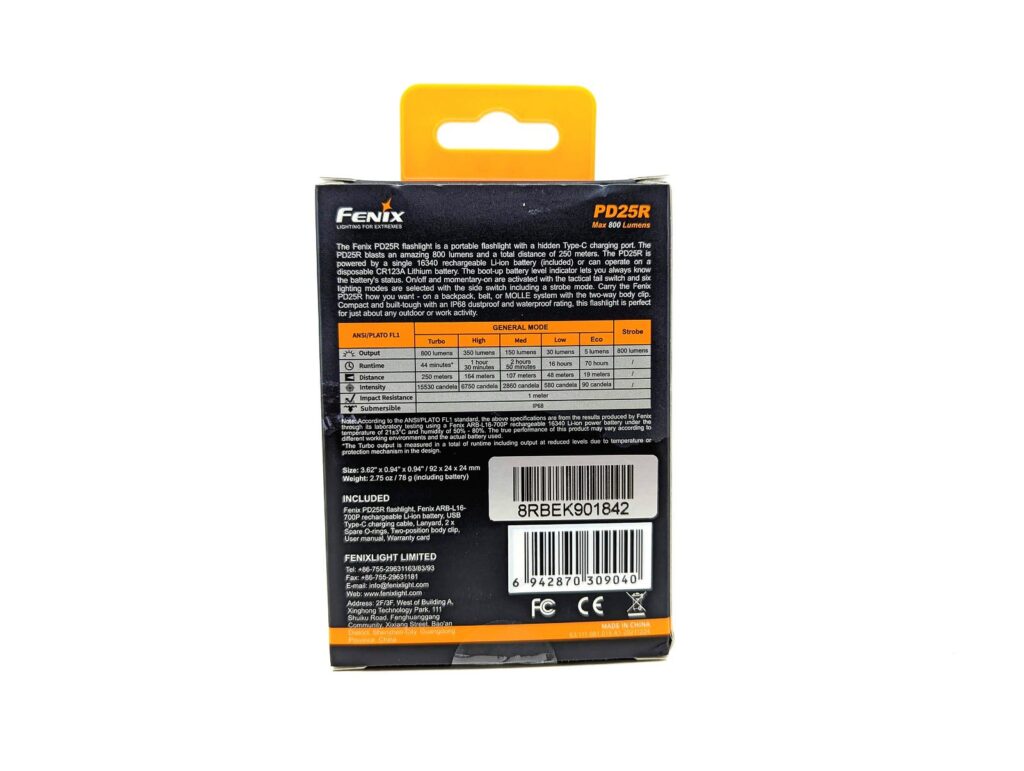
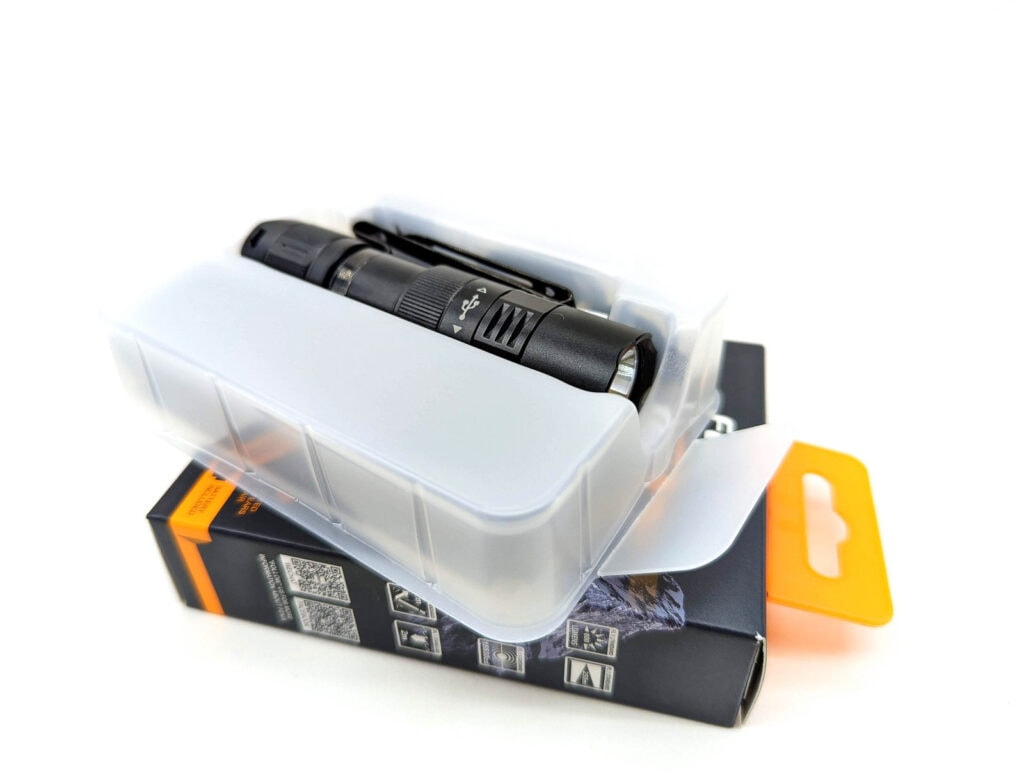
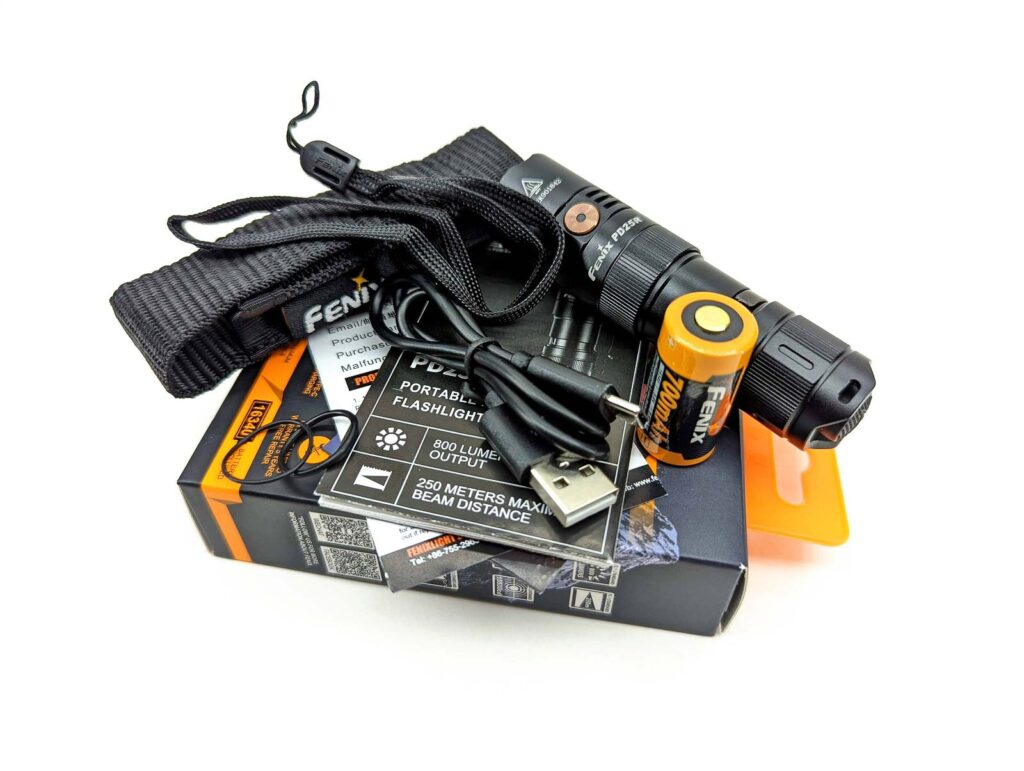
Flashlight in use
When I think of 16340-based lights, I usually think of tiny little flashlights lik the Fenix E18R V2.0 that I just reviewed. The PD25R is not one of those lights. It’s larger than my Convoy S2+ with an 18350 tube, and I feel that it’s large for a 18350 light – and this uses the even smaller 16340 battery. There are a couple reasons for the increased size. First off, this is a dual-switch light, so there’s stuff going on in both the tail as well as in the driver cavity. Also, it has built-in USB-C charging which takes up a bit of space. Lastly, sometimes extra mass can be a good thing – it provides more space for thermal dissipation.
The Fenix PD25R has two switches: a forward-clicky in the tailcap and an e-switch in the head. The forward-clicky allows for silent momentary activation, which is handy if you’re going to use this in a tactical fashion. I’m not a tactical expert, but I would say this light would be fairly good in tactical or duty applications. The dual-switch UI helps with this, especially with the momentary switch. The light does have mode memory though, so you’ll need to know the mode it was in when you last turned off the light.
Fenix provided a few options for carrying the PD25R. One of the most common choices would be the two-way pocket clip that came pre-installed on the light. It works well and the bends are spacious enough thicker material like jeans. There was also a lanyard included in the package, though I couldn’t see myself using it – it’s pretty lightweight, but at least you do have that option. Lastly, Fenix also included a handy holster. The holster isn’t anything too fancy, but does provide a sturdy and reliable way to carry the flashlight, keeping it at easy reach yet firmly secured at your side.
Due to the saddle-style tailcap machining and because the tail switch protrudes from the end of the light, the Fenix PD25R does not tail-stand.
I could see the Fenix PD25R being right at home in a lot of settings due to its dual-switch design, good workmanship, and stable output. Activities like hiking, camping, light-duty patrol, or even working on cars (the technicians I know love momentary switches, though pen lights are usually more of their thing).
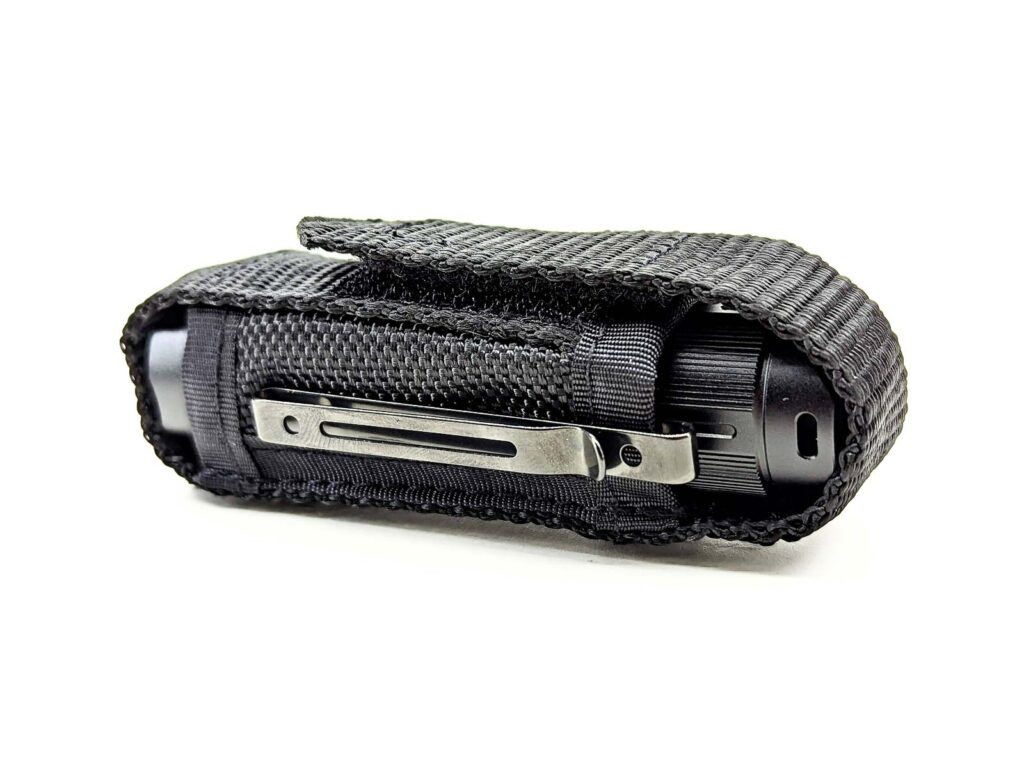
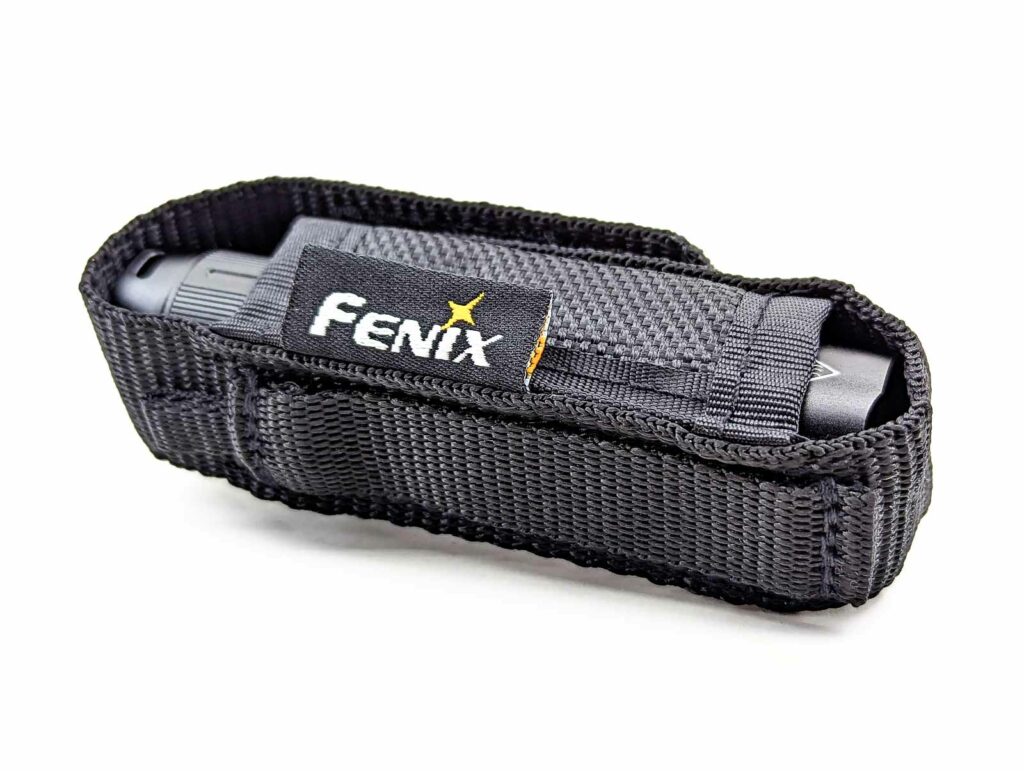
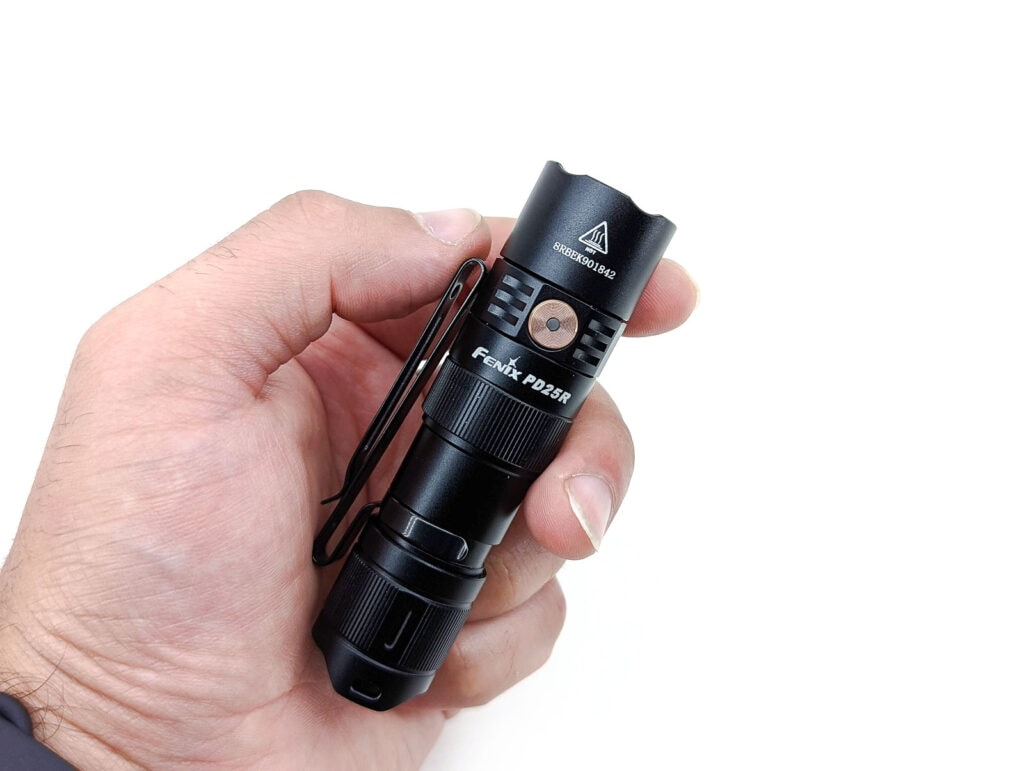
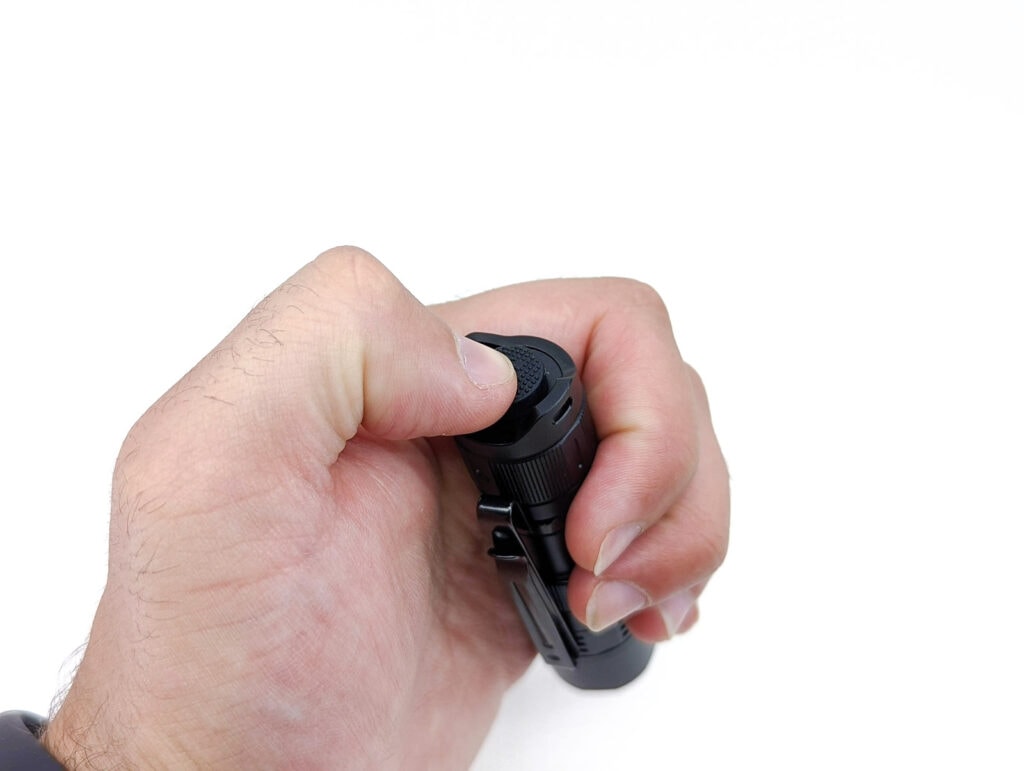
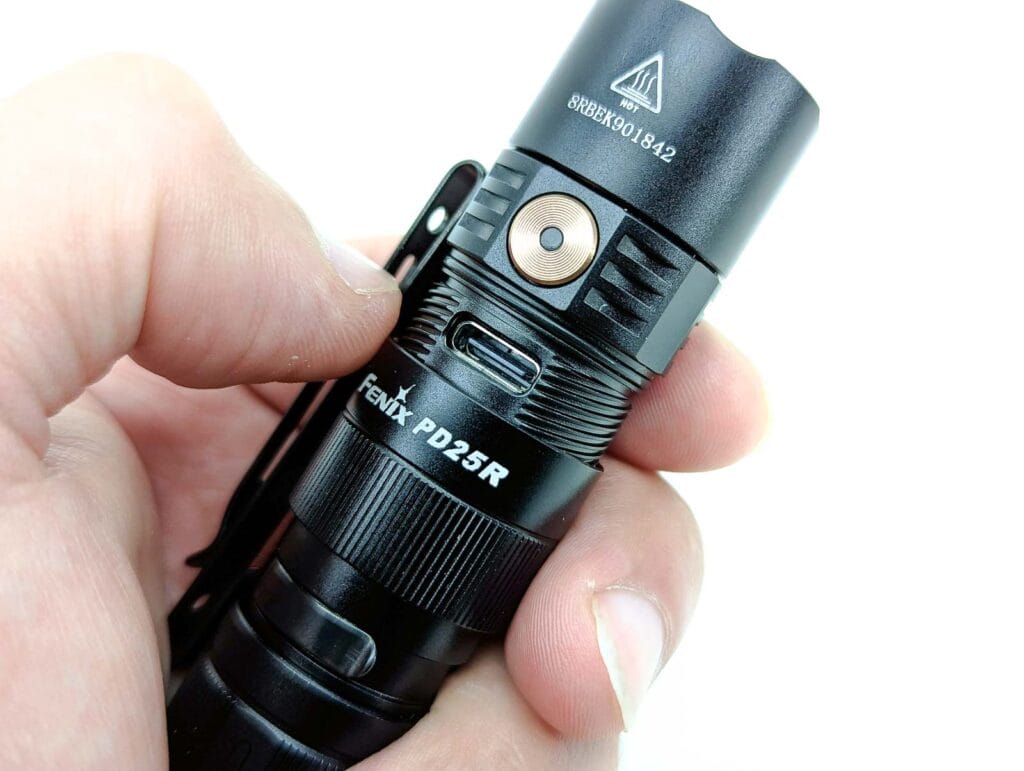
Build Quality, and Warranty
Fenix used A6061-T6 aluminum in the construction of the PD25R, then coated it in premium type III hard anodizing. The fit and finish look absolutely great, as I’ve come to expect from Fenix.
There’s no knurling to speak of. There are tiny grooves machined into the battery tube but they don’t provide much grip. Likewise, there are some light grooves in the tailcap that assist slightly when removing and installing the tailcap.
Warranty:
- 15 days from date of purchase: replacement from Fenix for manufacturing defects
- 5 year from date of purchase: free repairs
- Lifetime maintenance, with customer covering the cost of parts
- Extra 6 month warranty period for products registered on Fenix’s website
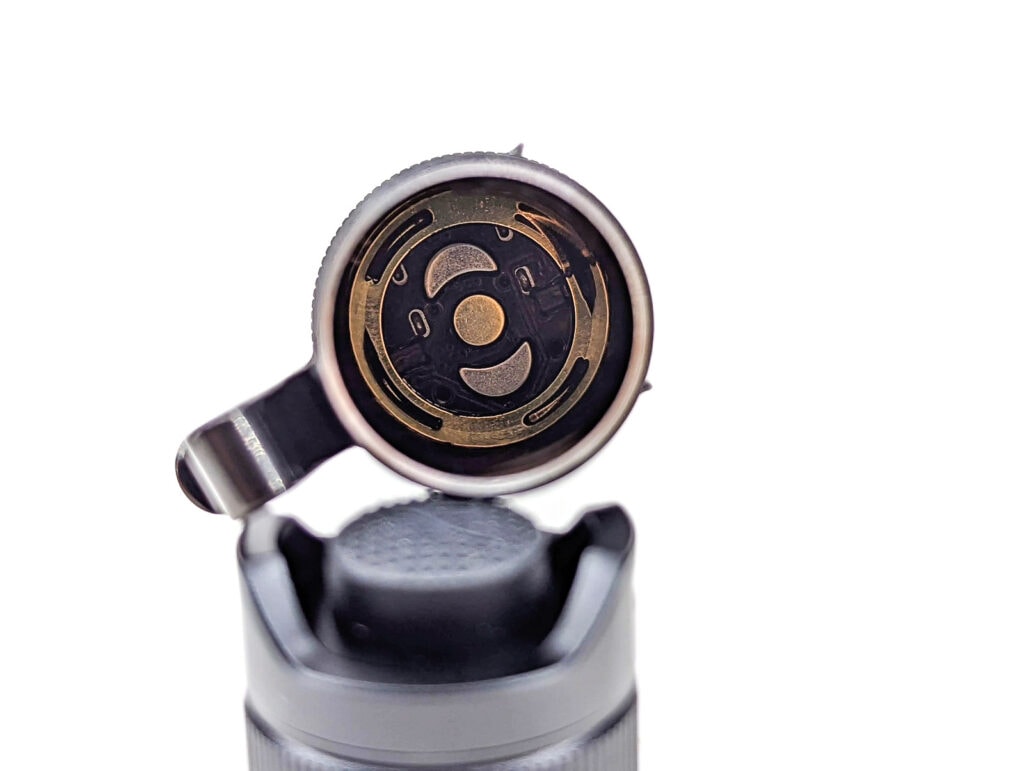
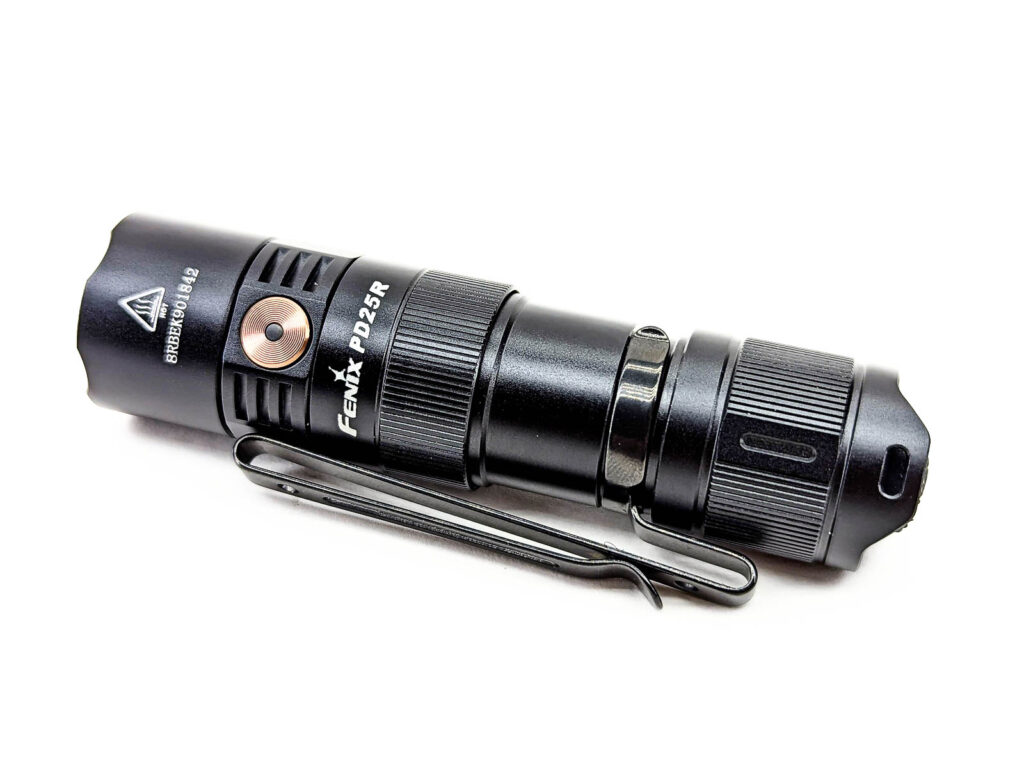
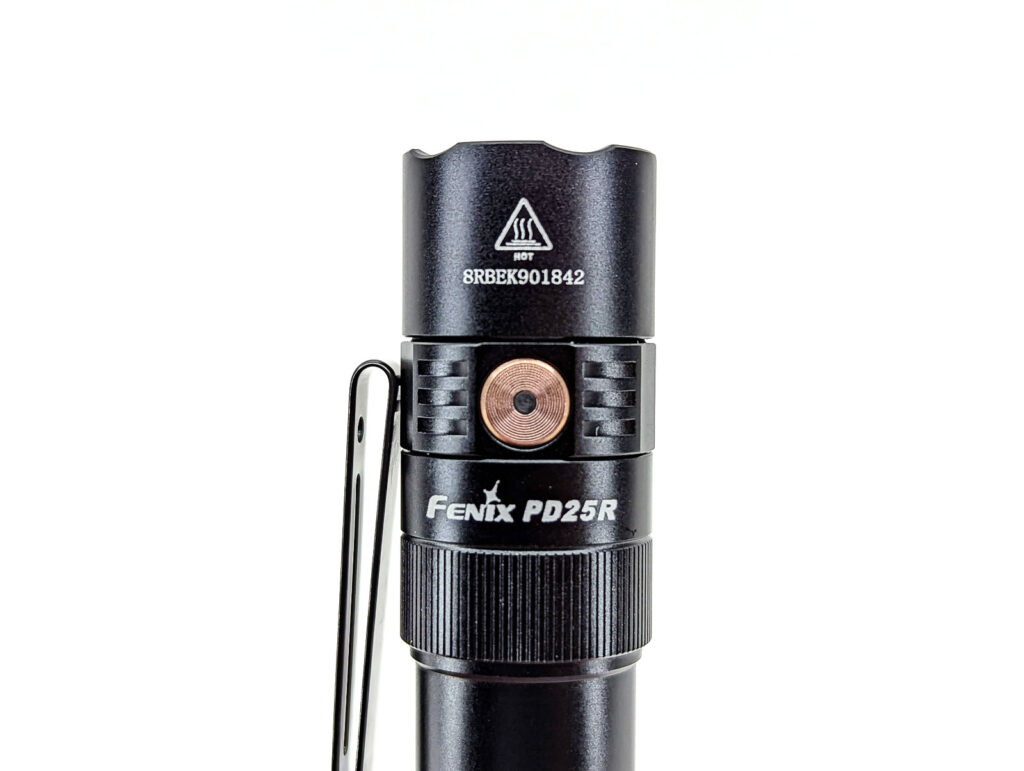
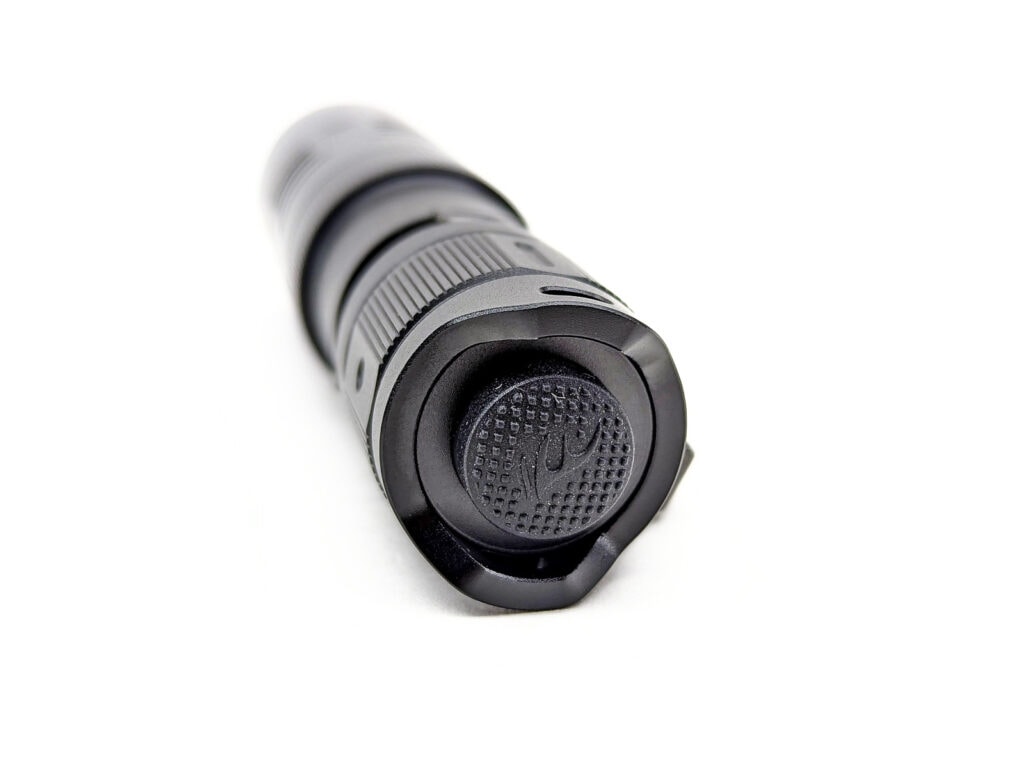
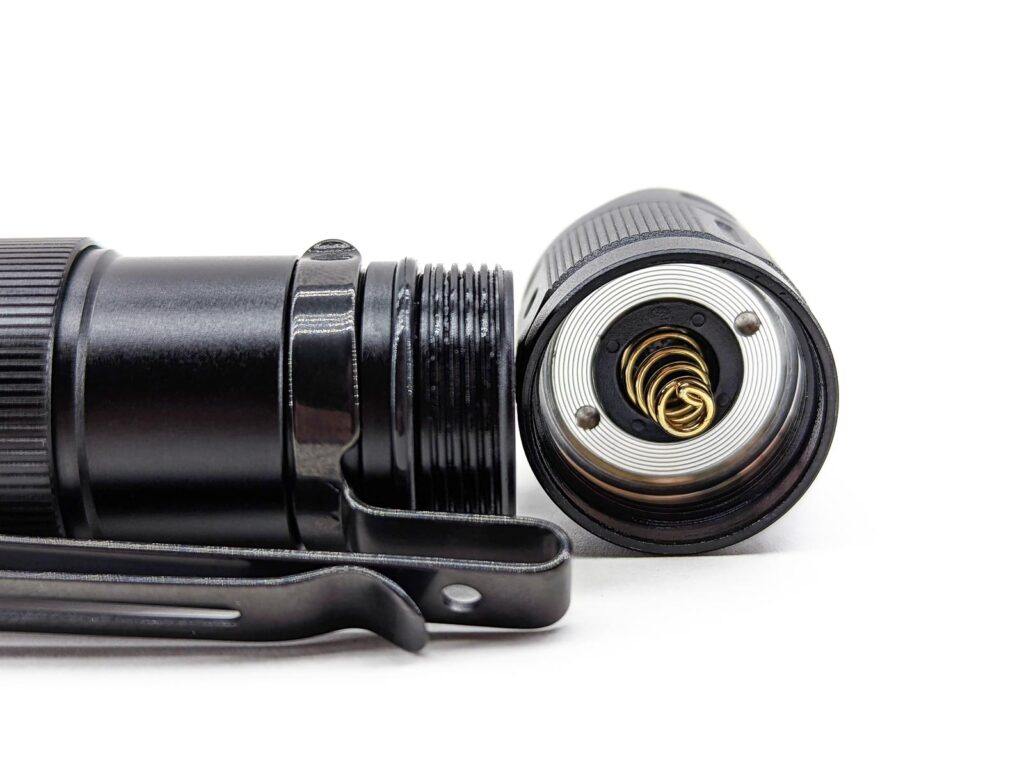
LED, Lens, Bezel, Beam, and Reflector
Fenix went with a Luminus SST20 LED for the PD25R. This is a pretty common LED that is reasonably efficient and throwy, even with the dome still on. While many enthusiasts prefer the 4000K 95-CRI version, this isn’t a BLF-endorsed enthusiast light. It’s a light as a tool, a light for the masses. So we’re looking at a cool white, normal-CRI version. The LED is nicely centered in a smooth reflector which makes for a throwy beam considering the size of the flashlight. Those items are protected by a piece of anti-reflective glass and held in place by a lightly crenulated bezel that is made of anodized aluminum to match the rest of the light. The beam profile consists of a rather defined (slightly green) hotspot and a dim bluish spill.
I got the following measurements of the center of the beam with my Opple Light Master at 1 meter with the Fenix being on Turbo:
- CCT: 5448K
- CRI: 62.1 Ra
- DUV: +0.0141
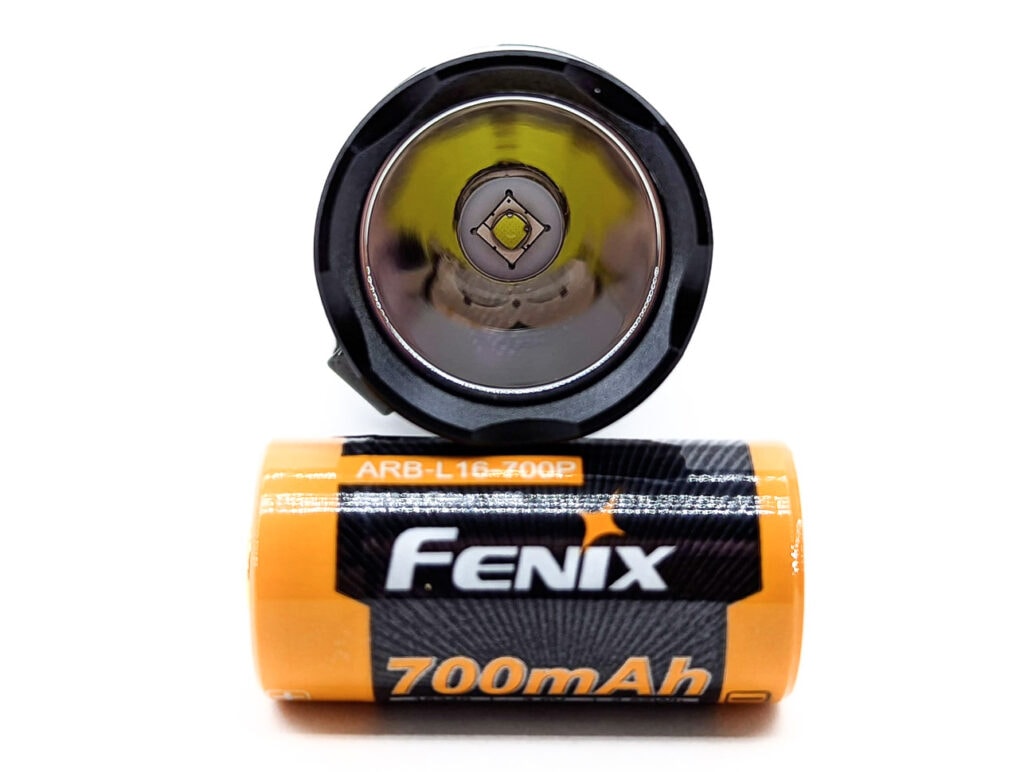
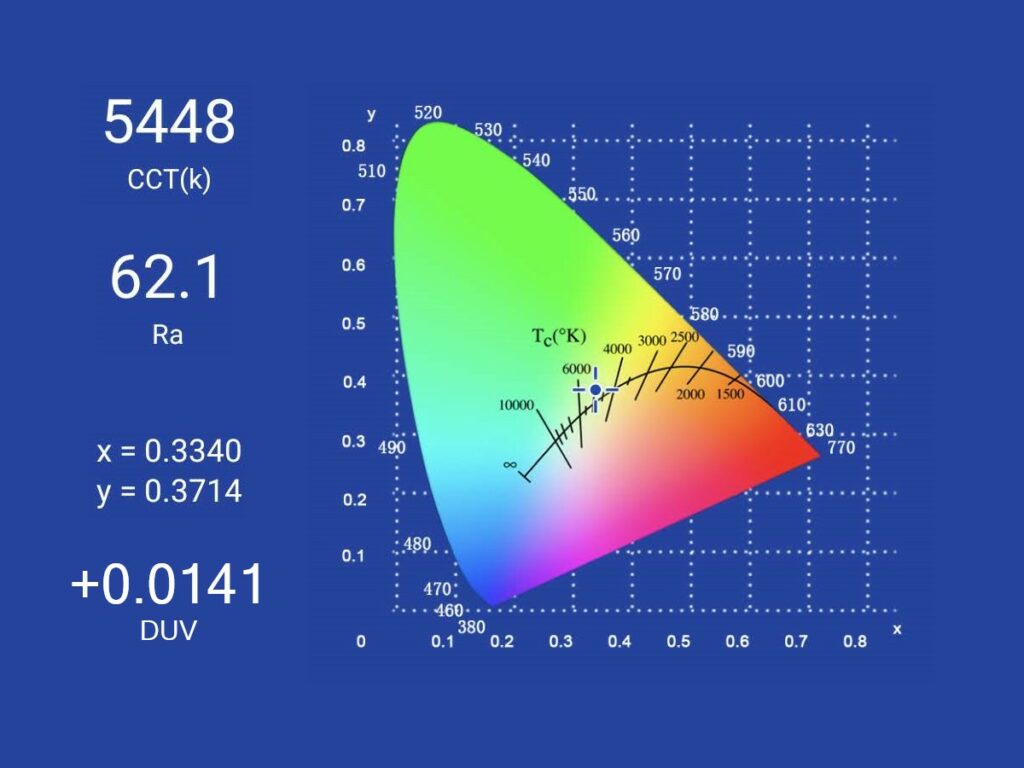
Dimensions and size comparison
Dimensions:
| Dimension | Millimeters | Inches |
|---|---|---|
| Length | 92 | 3.62 |
| Head diameter | 24 | 0.94 |
| Body diameter | 24 | 0.94 |
Weight:
| Weight | Grams | Oz. |
|---|---|---|
| Without battery: | 58 | 2.04 |
| With battery | 78 | 2.75 |
Flashlight size comparison with its competition
Group 1: Fenix E18R V2.0, Rovyvon S3, Fenix PD25R
Group 2: Wuben X-0, ThruNite T1S, Fenix PD25R, Wurkkos TS10, Sofirn SP10 Pro

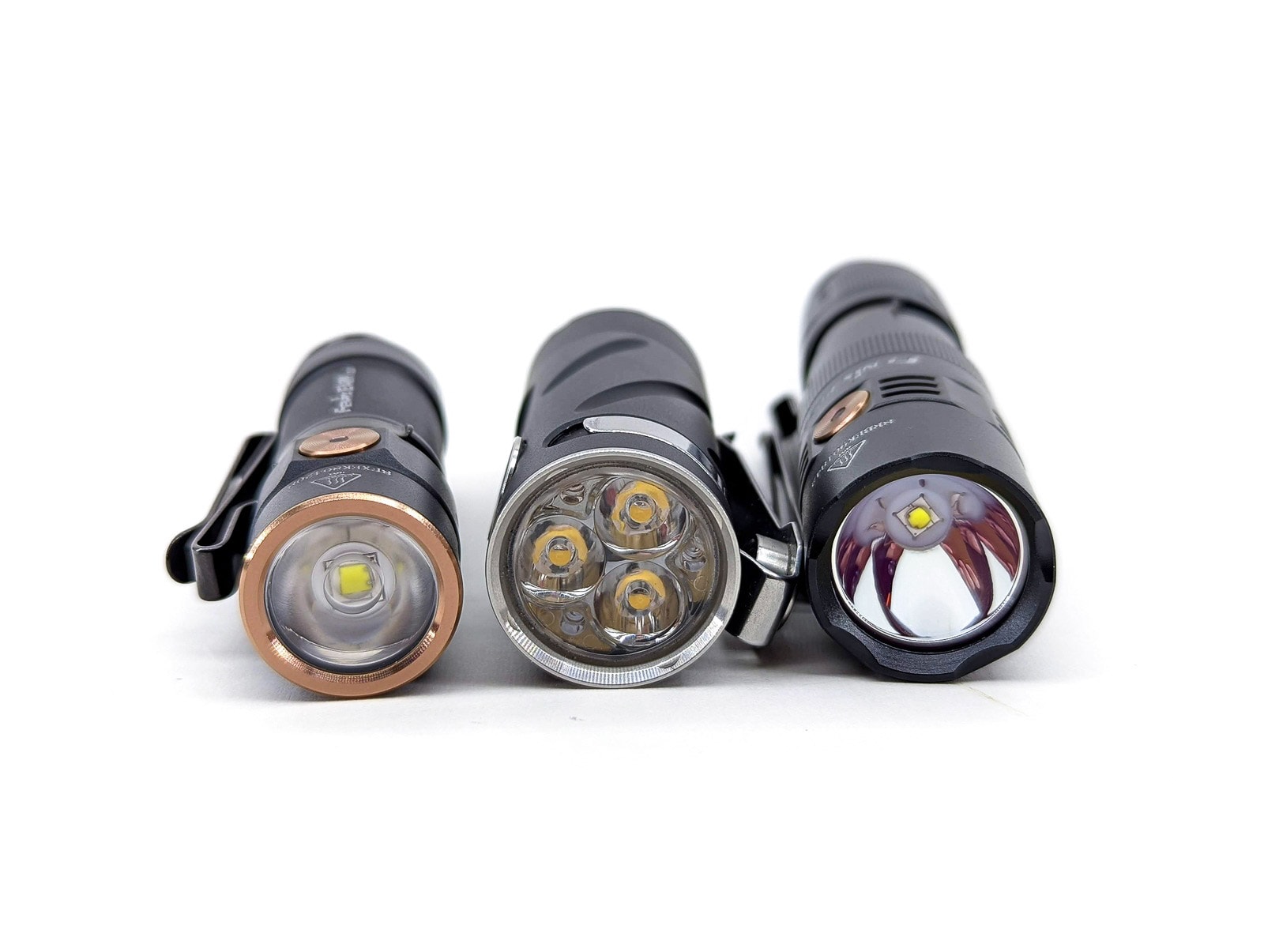
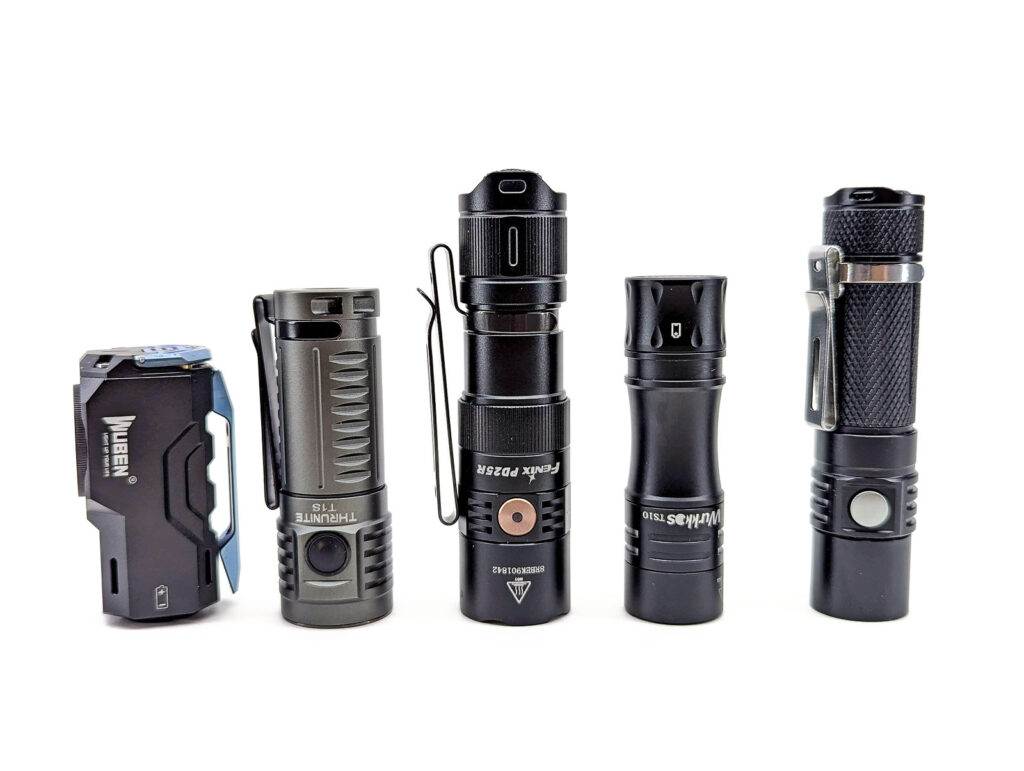
Driver & User Interface:
The Fenix PD25R uses a pretty standard dual-switch UI. The tail switch is for on/off, the side switch is for mode changes.
Available modes: Eco, Low, Medium, High, Turbo
Available blinky modes: Strobe
User interface:
From OFF:
- Press and Hold rear switch: momentary on
- Single click rear switch: turn on
From ON:
- Press and Hold side switch 0.5 seconds: Strobe
- 1 click side switch: change modes
- 1 click rear switch: turn off
Mode memory:
- Yes, there is mode memory
Shortcuts:
- To Strobe: while on, hold side switch 0.5 seconds
Low voltage warning:
- When the battery voltage gets low, output will step down until it reaches Moonlight (at which point the indicator LED will start flashing red)
- There is a battery indicator LED in the middle of the switch that activates for 3 seconds when you turn the light on:
- Green solid: 100-85%
- Green flashing: 85-50%
- Red solid: 50-25%
- Red flashing: 25-1%
Strobe/blinkies
- Strobe, activated by a 0.5 second hold of the side switch while on
Lock-out mode:
- No electronic lockout, but I suppose you could consider the tail switch to be a lockout
PWM
- No PWM is present
Additional info on the UI:
- N/A
Batteries & Charging
The Fenix PD25R arrived with a 16340 battery pre-installed, isolated by disc. The battery is a Fenix model ARB-L16-700P which is a 700 mAh cell with a protection circuit. The provided battery is of course the recommended model, but Fenix says that other batteries in their ARB-L16 series are compatible and that CR123A cells are also usable – but of course, do not use the charging feature with these non-rechargeable batteries. I tried a Vapcell T6 battery that I had on hand and it worked just fine.
The flashlight has USB-C charging built-in and comes with a USB-A to USB-C cable. The USB-C port is protected from water and dust by a threaded ring at the base of the head of the light. Twist the ring to reveal the hidden port that is sealed off by o-rings. Fenix says it should take around 2 hours to fully charge a depleted 700 mAh battery. I put the cord into my USB meter and saw a 0.55 amp charge rate (2.9 watts). The charge cycle took 1 hour and 40 minutes to complete with the final battery voltage being 4.21 volts.

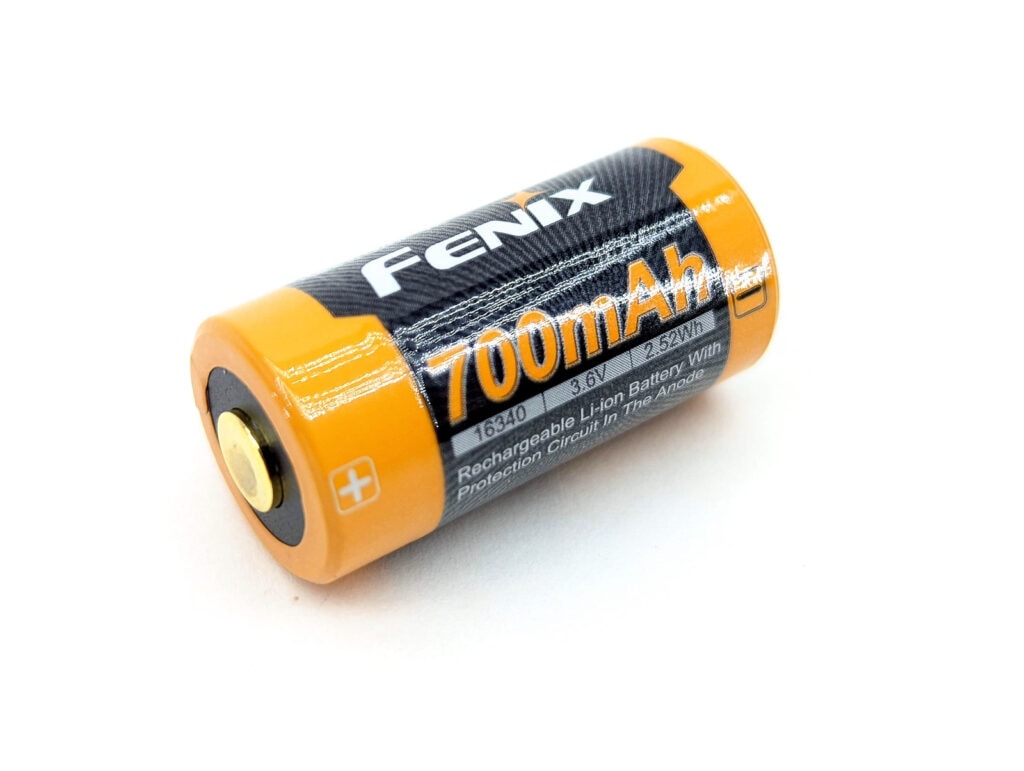
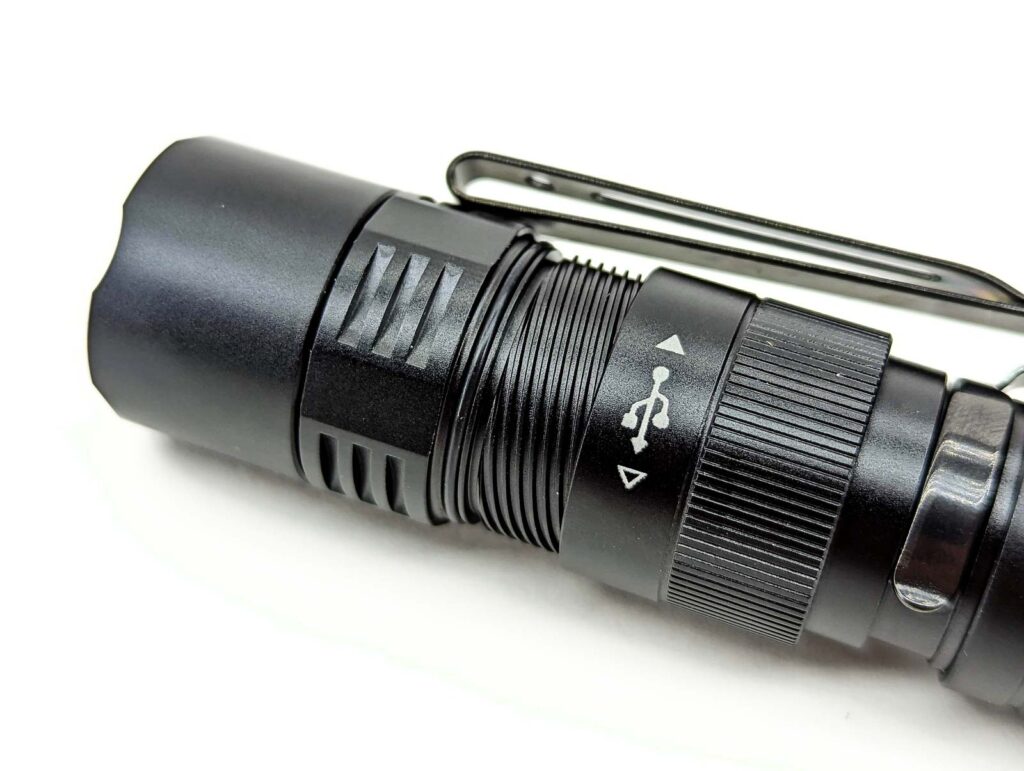
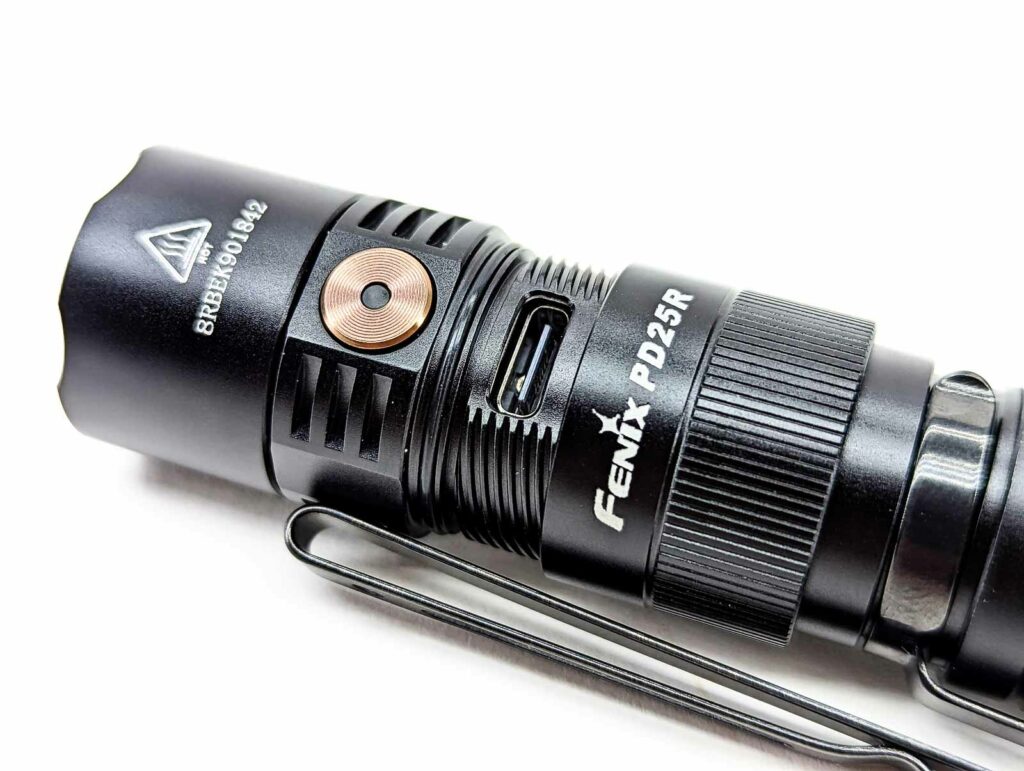
Performance test
Lux was measured by a UNI-T UT383 BT at 5 meters. Lumens were measured in a homemade lumen tube using a TSL2591 sensor, calibrated with a Maukka calibration light. The temperature was monitored with a MLX90614 IR temperature sensor. The included Fenix battery was used for testing.
Lumen measurements
| Mode | Amps at start | Specs | turn on | 30 sec | 10 minutes |
|---|---|---|---|---|---|
| Eco | 10 mA | 5 lm | 4.4 lm | 4.4 lm | – |
| Low | 44 mA | 30 lm | 26 lm | 26 lm | – |
| Medium | 235 mA | 150 lm | 148 lm | 147 lm | 144 lm |
| High | 0.7 A | 350 lm | 348 lm | 342 lm | 333 lm |
| Turbo | 2.1 A | 800 lm | 828 lm | 797 lm | 362 lm |
| Turbo at 3.6V | – | – | 628 lm | 560 lm | 24 lm |
Parasitic drain:
- N/A, it’s a clicky-switch
Battery Life: Runtime graphs

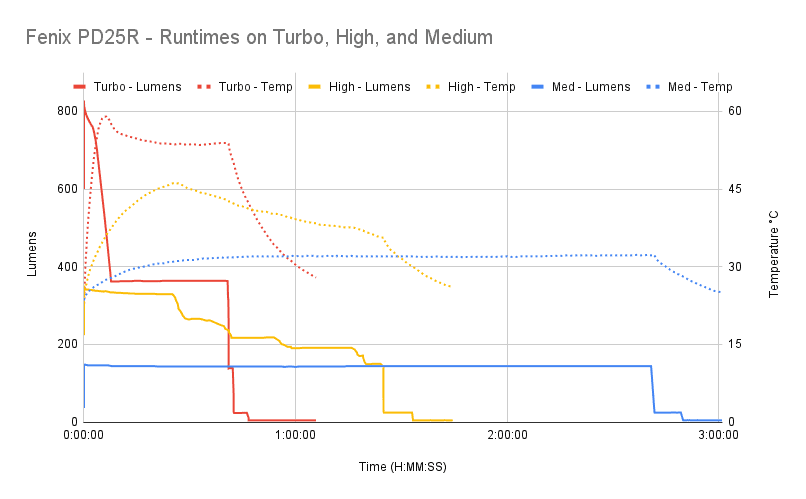
| Mode | Specified | Measured runtime (ANSI) | Time till end of test |
|---|---|---|---|
| Eco | 200 hr | – | – |
| Low | 15 hr | – | – |
| Medium | 2 hr 30 min | 2 hr 50 min | 3 hr 57 min+ |
| High | 1 hr 20 min | 1 hr 25 min | 6 hr 7 min+ |
| Turbo | 30 min | 42 min | 2 hr 1 min+ |
The PD25R continued to run for a while, my tests stopped when the light level got below 3 lumens for 3+ minutes.
ANSI FL1 standards: The runtime is measured until the light drops to 10% of its initial output (30 seconds after turning on). This does not mean that the flashlight is not usable anymore. The last column shows how long the light actually works till it shuts off. If there is a + symbol, it means that the test was stopped at that particular point, but the light was actually still running. This happens on certain occasions, with certain drivers, firmware, or batteries.
Peak beam intensity and beam distance measurements
Measured at 5 meters after 30 seconds with my UNI-T UT383 BT
| Mode | Specs | Candela measured | Meters | Yards |
|---|---|---|---|---|
| Eco | 90 cd | – | – | |
| Low | 580 cd | – | – | – |
| Medium | 2,860 cd | 2,675 cd | 103 | 113 |
| High | 6,750 cd | 6,600 cd | 162 | 178 |
| Turbo | 15,530 cd | 16,050 cd | 253 | 277 |
Extra info: Peak beam distance according to ANSI FL1 standards: The calculated value of distance in meters at which the flashlight produces a light intensity of 0.25 lux. (0.25 lux is about the brightness of a full moon shining on an object).
Beamshots
Beam shots of the building are taken at 15 m (16 yd) using a Pixel 6 set to ISO 200 with 1/10 second exposure time.
Beamshots compared to the following EDC flashlights:
- Fenix PD25R
- Fenix E18R V2.0
- Olight Arkfeld
- ThruNite T1S

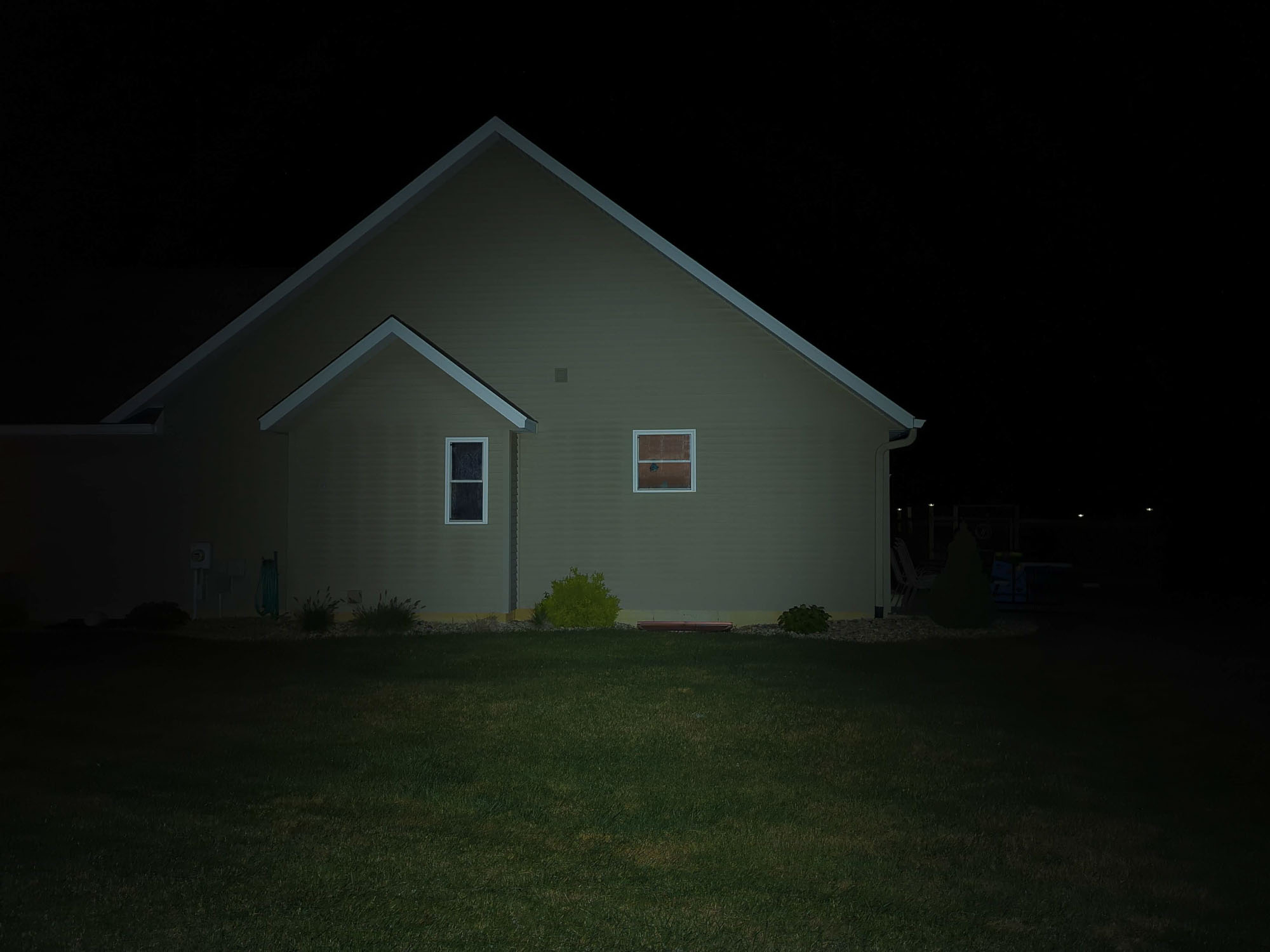
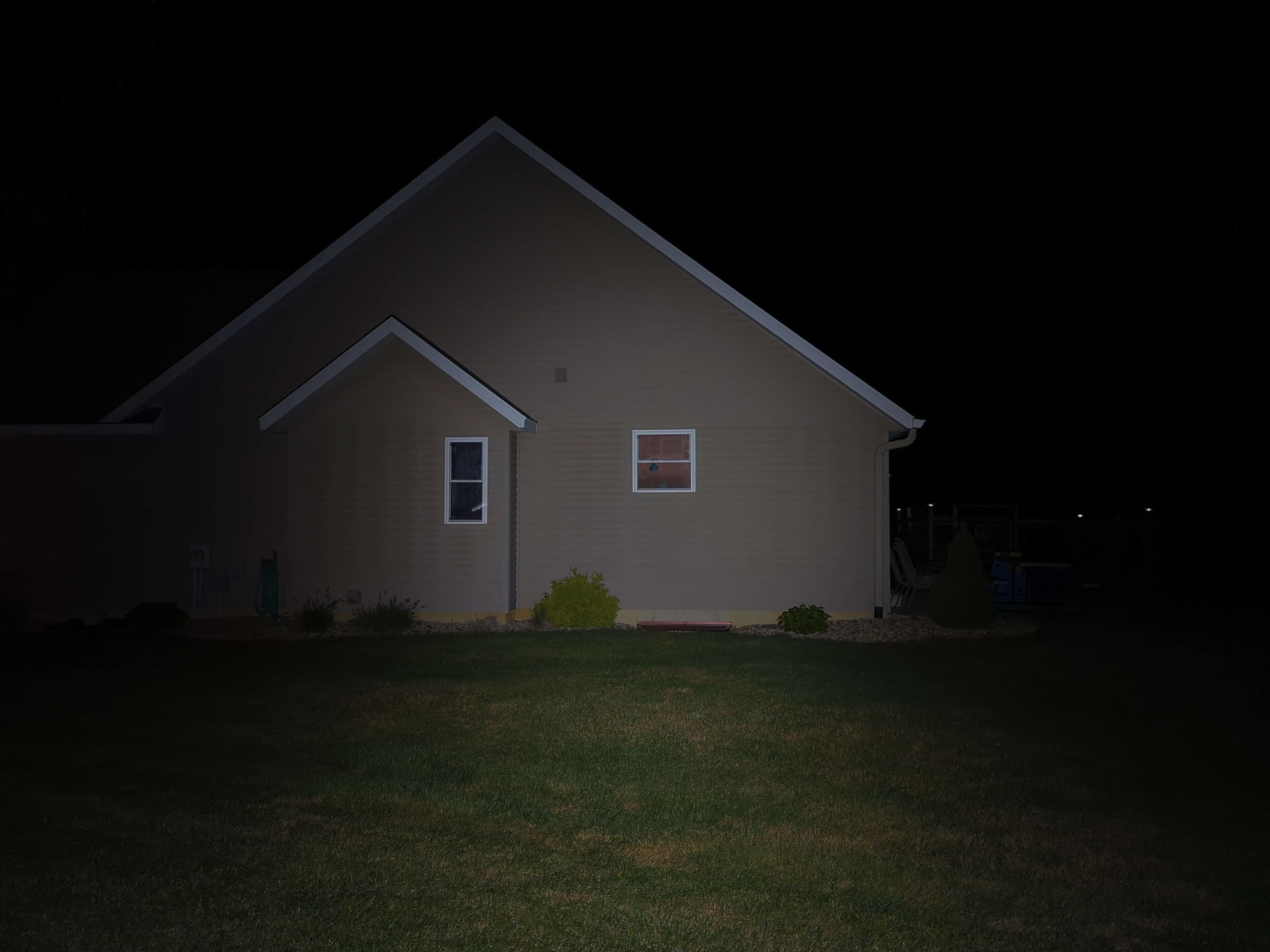

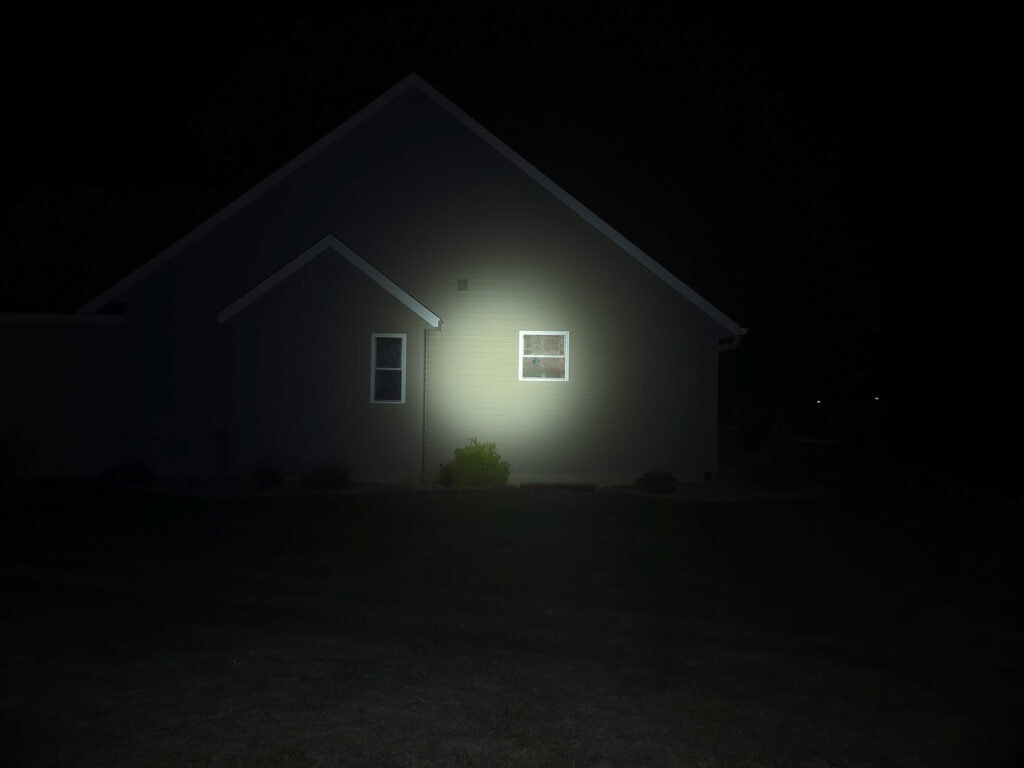

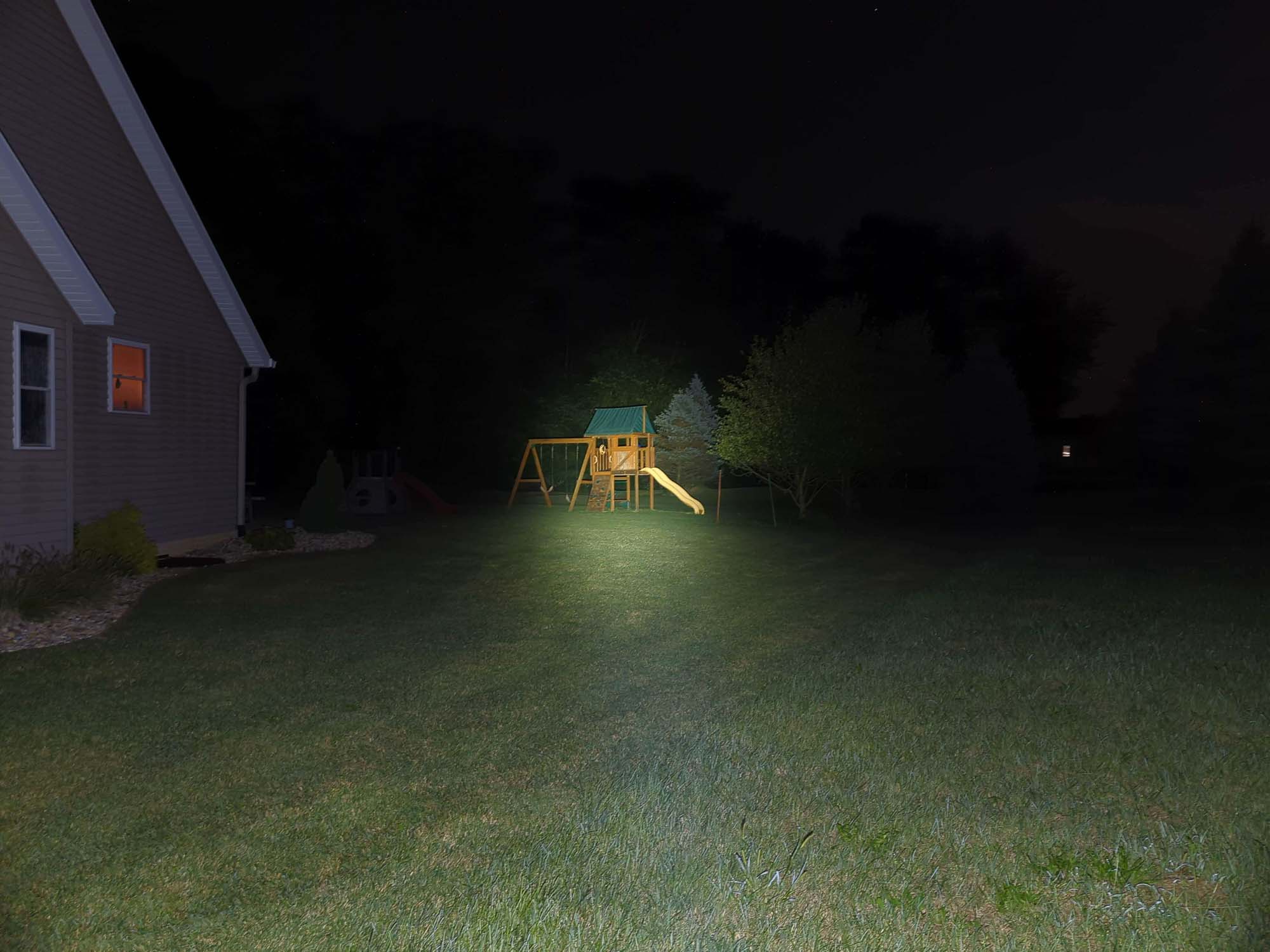

Disclaimer: This flashlight was sent to me for review at no cost by Fenix Lighting US. I have not been paid to review, nor have I been holding back on problems or defects.
Final Verdict
Pros
- Great build quality
- Excellent regulation
- USB-C charging
- Easy dual-switch UI
Cons
- A bit bulky for a 16340 light
- “Meh” CCT and tint (personal preference)
Explanation on star ratings:
1: Avoid: a match would be a better choice – 2: Poor: significant defect or issues; almost unusable – 3: Average: some defects or issues; but still usable 4: Good: recommended (minor issues) – 5: Great: highly recommended

4.5 stars: ★★★★⋆
There are all sorts of use cases for flashlights. I tried the Fenix E18R V2.0 and found it to be a really nice EDC, throw-in-your-pocket kinda light. This Fenix PD25R may take the same battery, but it’s a completely different animal – it falls squarely in the professional/tool realm. The Fenix PD25R would be right at home for activities like hiking, camping, or light-duty patrol due to its dual-switch design, good workmanship, and stable output..
Fenix PD25R For Sale & discount code
Get 10% off every purchase at Fenix Lighting US, by using our exclusive 1lumen discount code: 1lumen10
1lumen selects and reviews products personally. We may earn affiliate commissions through our links, which help support our testing.